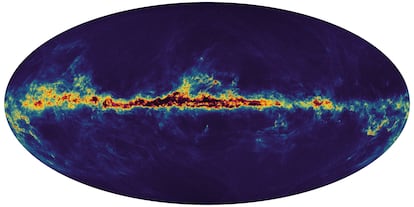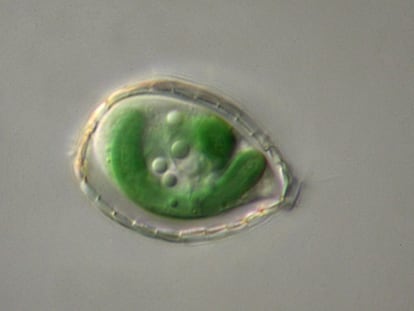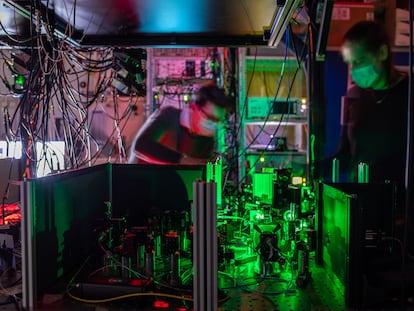The most complete map of the Milky Way reveals starquakes and cannibal galaxies
The new data from the European space telescope ‘Gaia’ has also identified different generations of stars, and the speed at which they are traveling to and away from Earth

A European space telescope capable of estimating the weight, age and temperature of a star just by looking at it has completed the largest map of the Milky Way galaxy.
The robotic spacecraft, called Gaia, was launched by the European Space Agency in 2013. It was sent to the Sun-Earth Lagrangian point, a privileged observation site 1.5 million kilometers from Earth, and from there it has observed 1.8 billion stars. Its mission is to chart a three-dimensional map of a large part of the Milky Way galaxy, which is home to the Solar System, and another 100 billion stars, many of them also with planetary systems.
This new batch of data – taken by Gaia between 2014 and 2017 – has created the most complete map of the Milky Way, a giant disk-like structure measuring 170,000 light-years in diameter, but only 1,000 light-years thick. The vast majority of stars are crowded in the center of the galaxy, which is characterized by two large spiral arms.
“Before this mission, it was as if we were inside a forest and we only saw trees, but now we are in the sky and we can see everything from a bird’s eye view,” Finnish astronomer Timo Prusti, scientific director of the project, explains to this newspaper. The researchers leading the mission at the European Space Agency presented the new data on Monday, coinciding with the publication of a collection of scientific studies that analyze the findings in depth.
The distances on the new map are staggering. Each light year is almost 10 trillion kilometers. The Earth and the rest of the Solar System travel around the center of the Milky Way, where there is a supermassive black hole called Sagittarius A*, at 720,000 kilometers per hour. But even at this speed, it will take 230 million years to make a complete revolution. In the same way, the Milky Way is a small island of stars that is traveling through an immense universe, where there are another 100 billion galaxies separated by mind-boggling distances.
The new map confirms that the Solar System is within the so-called “Local Bubble,” an area with few stars and with a low concentration of gases and interstellar dust, which allows a fairly clear view of the rest of the galaxy, Prusti points out.
Before this mission, it was as if we were inside a forest and we only saw trees, but now we are in the sky and we can see everything from a bird’s eye viewFinnish astronomer Timo Prusti
Gaia has also observed stars being born inside a young galaxy called Gaia-Enceladus that was devoured by the Milky Way 10 billion years ago. “We have discovered other galaxies that have also been absorbed by ours. This helps us understand that some galaxies, including the Milky Way, grow and evolve by assimilating others,” explains Prusti.
This is the third batch of data provided by Gaia since its launch in 2013, but it is the first time, the mission has provided key information on the speed at which 33 million stars are moving away from or towards us. Carme Jordi, an astronomer involved in the mission, explains another of the main discoveries. “Now we not only know how bright the stars are, but we can break them down into a prism of different colors, which shows us which chemical elements are most abundant. From this, we can learn if the stars are very cold or hot, if they have just been born or are already very old,” explains the researcher. This data is now available for 200 million stars, which makes it possible to identify the different generations of stars in the galaxy.
What’s more, Gaia captures such high-definition images that it can even pick up small changes in the shape of some stars. These measurements revealed stars whose surface had been deformed as if they had been hit by an earthquake – a phenomenon known as a starquake. “Suddenly there is a sudden change inside the star whose effects move outwards and modify the outer layers, just as a tsunami stirs the surface of the sea [on Earth],” explains Jordi.
These phenomena can be very useful for understanding the inside of stars, which cannot be seen with conventional telescopes. This is where the star generates all its energy through the nuclear fusion of hydrogen atoms to form helium. One of the biggest scientific projects today is to find a way to produce this nuclear fusion in reactors on Earth – a feat that could generate virtually inexhaustible and clean energy.
The Gaia mission will continue to collect data on stars and other objects within the Solar System and beyond the Milky Way until 2025, when its scientific operations are scheduled to end.
Tu suscripción se está usando en otro dispositivo
¿Quieres añadir otro usuario a tu suscripción?
Si continúas leyendo en este dispositivo, no se podrá leer en el otro.
FlechaTu suscripción se está usando en otro dispositivo y solo puedes acceder a EL PAÍS desde un dispositivo a la vez.
Si quieres compartir tu cuenta, cambia tu suscripción a la modalidad Premium, así podrás añadir otro usuario. Cada uno accederá con su propia cuenta de email, lo que os permitirá personalizar vuestra experiencia en EL PAÍS.
¿Tienes una suscripción de empresa? Accede aquí para contratar más cuentas.
En el caso de no saber quién está usando tu cuenta, te recomendamos cambiar tu contraseña aquí.
Si decides continuar compartiendo tu cuenta, este mensaje se mostrará en tu dispositivo y en el de la otra persona que está usando tu cuenta de forma indefinida, afectando a tu experiencia de lectura. Puedes consultar aquí los términos y condiciones de la suscripción digital.
More information
Últimas noticias
Most viewed
- Sinaloa Cartel war is taking its toll on Los Chapitos
- Oona Chaplin: ‘I told James Cameron that I was living in a treehouse and starting a permaculture project with a friend’
- Reinhard Genzel, Nobel laureate in physics: ‘One-minute videos will never give you the truth’
- Why the price of coffee has skyrocketed: from Brazilian plantations to specialty coffee houses
- Silver prices are going crazy: This is what’s fueling the rally











































